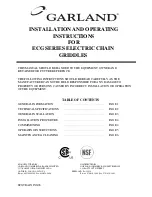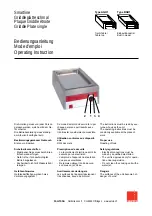
7
3.
Remove the grease drawer, empty and wash thoroughly with soap & water. Replace.
CLEANING INSTRUCTIONS (FOR HEAVY BUILD UP)
(After using cleaners & grease cutter, re-season the griddle)
Apply to a warm griddle for best results.
1.
Using a traditional 64mm-76mm (2 ½”-3”) scraper or spatula scrape the griddle surface (to
remove food particles and oil residues) towards the grease trough using even back to front
strokes. Deposit debris into the chute.
2.
Apply griddle cleaner evenly over the griddle surface and let sit as directed. Follow the
procedures on the label of the specific cleaning product.
3.
Using a traditional scraper or spatula, slosh around the griddle cleaner to remove the build up.
4.
Scrape the griddle surface towards the grease trough using even back to front strokes. Repeat
step 2 if necessary.
5.
Using a mild detergent, clean the surface and rinse thoroughly with a water and vinegar
solution. Dry griddle.
6.
Using a clean cloth rub a thin and even layer of oil into the griddle surface.
7.
Re-season the griddle
as detailed above. The griddle is now ready for use.
GRIDDLE DO’S & DON’TS
DO’S
1.
Season the griddle. This will prevent foods from sticking and make it easier to keep the
surface clean.
2.
Keep the surface clean. Scraping the surface throughout production to clear foods and oils
prevents build up and will make it easier to keep the surface clean.
3.
Turn the temperature down during slow periods. Reducing the temperature or turning
sections off during slow periods will conserve energy and prevent the plate from overheating.
DON’TS
1.
Do not use salt to clean the griddle surface. Salt is corrosive and can cause pitting of the
griddle.
2.
Do not allow metal utensils (Spatula, scraper, etc.) to nick and/or dent the surface of the
griddle. The edges of these utensils are sharp and will create divots that oil can collect in and
caramelize which will cause sticking.























